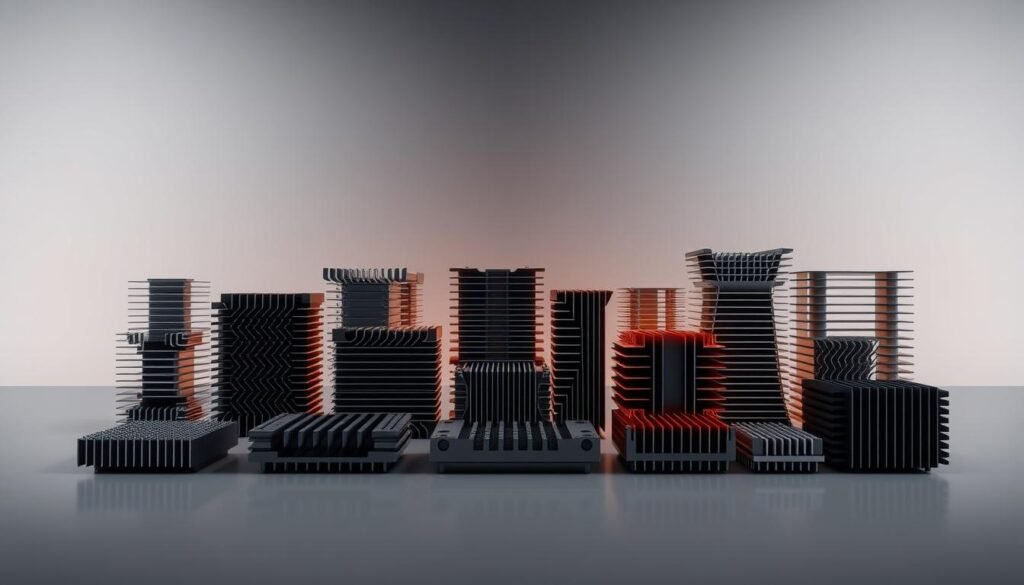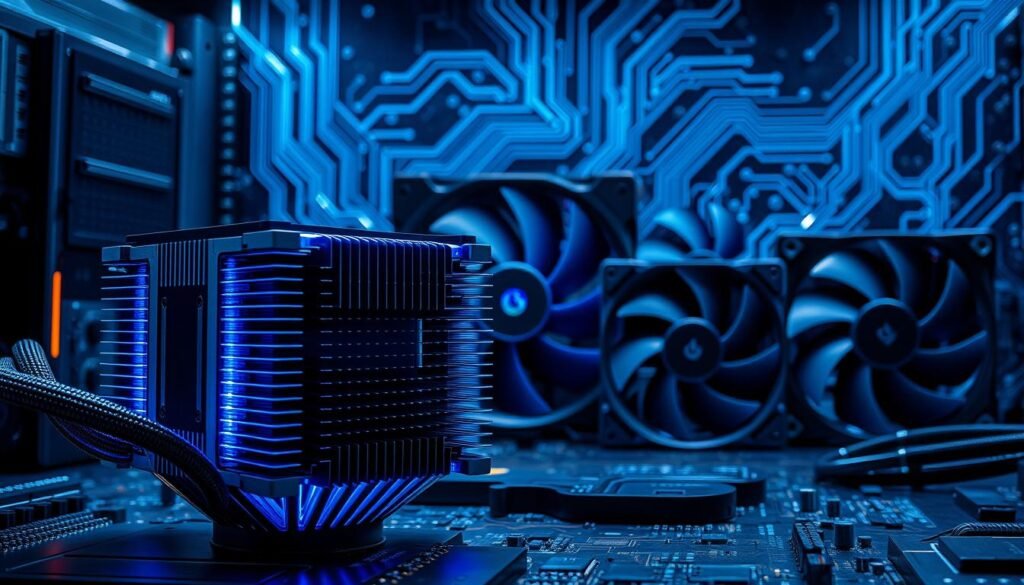Electronic devices get very hot when they work. This heat can hurt their performance and make them less reliable. A heat sink helps by taking away this extra heat. It keeps sensitive parts safe from damage.
The main job of a heat sink is to move heat away from important parts. It does this by spreading out the heat over a large area. This keeps devices like computers and phones from getting too hot.
Keeping electronics cool is a big challenge. Modern heat sinks use smart designs to move heat away. This lets complex systems work well without overheating.
Designers and engineers know that managing heat is key. It’s not just about avoiding overheating. It’s about making devices that last a long time and work well under tough conditions.
Understanding the Basic Function of Heat Sinks
Heat sinks are key in managing heat in electronic systems. They help transfer and dissipate heat, protecting sensitive parts. Knowing how they work helps engineers make better cooling systems.
Heat sinks work well thanks to some important scientific principles. These principles help them transfer heat and manage temperature in devices. The right materials and design make them effective.
Principles of Thermal Conductivity
Thermal conductivity shows how well a material can carry heat. Materials like aluminum and copper are great at this. They have:
- Quick heat transfer
- A structure that helps energy move
- Fast thermal energy redistribution
Heat Transfer Mechanisms in Heat Sinks
Heat sinks use three main ways to handle heat:
- Conduction: Heat moves directly through touch
- Convection: Heat moves through air or fluid
- Radiation: Heat is released as electromagnetic waves
The Role of Surface Area in Heat Dissipation
Surface area is vital for efficient heat release. More surface area means more heat can be released. Designers improve heat sinks by:
- Creating complex fin structures
- Increasing surface coverage
- Improving air flow
Understanding these basics helps designers make heat sinks that tackle thermal issues in electronics. This ensures devices work well and last longer.
What Does a Heat Sink Do in Electronic Devices
Keeping electronic devices cool is a big challenge today. Heat sinks are key in managing heat to prevent damage. They act as protectors, keeping sensitive parts from getting too hot.
Heat sinks are designed to handle heat in electronic systems. They have a large surface area to quickly release heat from important parts like:
- Central Processing Units (CPUs)
- Graphics Processing Units (GPUs)
- Power transistors
- High-performance microprocessors
Good heat management means devices work better and last longer. Heat sinks are made to pull heat away fast. They turn heat into air through special heat transfer.
A well-designed heat sink can reduce component temperature by up to 30-40 degrees Celsius, significantly improving electronic device reliability.
Each electronic system needs its own heat sink design. Laptops, smartphones, gaming consoles, and industrial computers all need to stay cool to work well.
Knowing how heat sinks work helps engineers make better electronic devices. These devices can handle more work without losing performance.
Types of Heat Sinks and Their Applications
Heat sink technology offers many solutions for managing heat in different industries. Each type of heat sink has its own cooling method. These methods are designed for specific needs and environments.

Engineers create heat sinks to solve cooling problems in electronics. They focus on three main types: passive, active, and liquid cooling.
Passive Heat Sinks
Passive heat sinks use natural air flow to cool. They are simple but effective. They work without moving parts.
- They are made from materials like aluminum or copper that conduct heat well.
- They have no moving parts, which means they are less likely to break.
- They are best for devices that don’t use a lot of power.
Active Heat Sinks
Active heat sinks use fans to cool better. They are more advanced and work well in dense electronic systems.
| Feature | Passive Heat Sinks | Active Heat Sinks |
|---|---|---|
| Cooling Mechanism | Natural Convection | Forced Convection |
| Power Consumption | Zero | Medium |
| Performance Range | Low to Medium | High Performance |
Liquid-Cooled Heat Sinks
Liquid cooling is the top heat sink technology. It’s best for high-performance computing and industrial needs. It uses coolant to cool better than air.
- It has great heat transfer abilities.
- It keeps temperatures steady.
- It’s perfect for critical cooling needs.
Each heat sink type has its own benefits. Engineers can choose the best one for their system’s needs.
Materials Used in Heat Sink Manufacturing
Choosing the right materials for heat sinks is key for keeping electronic devices cool. The material’s ability to conduct heat and its properties play a big role.
Aluminum heat sinks are very popular. They are light and have many benefits:
- Low cost of production
- Excellent thermal conductivity
- Easy to manufacture and shape
- Corrosion-resistant properties
Copper heat sinks are another option. They are better at conducting heat but are heavier and pricier. They are best for situations where lots of heat needs to be removed.
New materials are being developed for heat sinks:
- Graphene-based composites
- Advanced ceramic materials
- Hybrid metal alloys
Engineers have to think about several things when picking heat sink materials:
| Material | Thermal Conductivity | Weight | Cost |
|---|---|---|---|
| Aluminum | Good | Light | Low |
| Copper | Excellent | Heavy | High |
The world of heat sink materials is always changing. New tech and higher performance needs in cooling electronics drive these changes.
Design Features and Efficiency Factors
Creating an effective heat sink design is all about paying attention to key factors. These factors greatly affect how well the heat sink works. Engineers aim to find new ways to make heat sinks better at cooling things down.
Designing a heat sink involves using complex engineering to meet both performance and manufacturing needs. It’s important for designers to look at several main parts carefully. This ensures the heat sink manages heat well.
Fin Configuration and Spacing
The way fins are set up is very important for a heat sink’s performance. The fins help move heat from the base plate to the air around it. Important things to think about include:
- Fin height and density
- Spacing between fins
- Airflow dynamics
- Material thermal conductivity
Base Plate Thickness
The base plate is where the heat from the component meets the heat sink. Precise thickness calculation is key for even heat distribution and less thermal resistance.
- Thicker base plates spread heat better
- Material choice affects how well it conducts heat
- Precision machining makes sure it contacts surfaces well
Surface Treatment Options
Surface treatments can make a heat sink work much better by improving how it transfers heat. These treatments can:
- Make the surface area bigger for better heat release
- Lower thermal resistance
- Protect against corrosion
- Make the heat sink last longer
Common surface treatments include anodizing, nickel plating, and special coatings. These methods help improve the efficiency of heat sinks in different situations.
Common Applications in Consumer Electronics

Heat sinks are key in modern gadgets, keeping them running well and lasting longer. They are vital for cooling down devices that get very hot. This is true for high-tech items that produce a lot of heat.
CPU heat sinks are well-known in computers. They stop the processor from overheating by spreading out the heat. This is important because today’s CPUs can get very hot, affecting how well they work.
- Computers and laptops use advanced heat sink designs
- Gaming systems require robust GPU cooling mechanisms
- Smartphones incorporate miniaturized thermal management solutions
GPU cooling is also very important. Graphics cards get very hot when they’re working hard. So, they need special heat sinks to keep them cool. These heat sinks have lots of heat pipes and big aluminum fins.
LEDs also need good cooling. They get hot and need to stay cool to shine brightly and last long. Heat sinks fit right into LED lights to help with this.
“Effective thermal management is the silent guardian of electronic performance and reliability.” – Electronics Engineering Quarterly
Other gadgets that use heat sinks include:
- Audio amplifiers
- Power supply units
- Gaming consoles
- High-end home entertainment systems
As gadgets get better, they need better cooling. This cooling must be efficient, work well, and be small.
Industrial and High-Performance Computing Applications
Heat sinks are key in managing heat in complex industrial settings. As technology gets better, the need for good heat management grows. This is true for high-performance computing and special electronic systems.
Modern industries need smart ways to cool down to keep systems running well. This prevents failures. Let’s look at where heat sinks really make a difference.
Data Center Cooling Solutions
Data centers need top-notch heat sink tech. Servers make a lot of heat. So, keeping them cool is vital for their reliability and performance.
- Precision-engineered industrial heat sinks reduce server temperature fluctuations
- Advanced cooling solutions minimize energy consumption
- Specialized thermal management prevents critical equipment failures
Automotive Electronics Cooling
Car electronics are getting more complex. They need smart cooling to protect sensitive parts. Modern cars use strong heat sink designs for this.
| Automotive Component | Heat Sink Application | Thermal Management Challenge |
|---|---|---|
| Electronic Control Units | Aluminum heat sinks | High-temperature environments |
| Battery Management Systems | Copper heat spreaders | Temperature regulation |
| Power Electronics | Liquid-cooled heat sinks | Extreme heat dissipation |
Power Electronics Applications
Power electronics in green energy and industrial gear need strong cooling. Innovative heat sink designs help them work well in tough spots.
- Solar inverter thermal control
- Wind turbine power electronics cooling
- Industrial motor temperature regulation
Effective thermal management is the cornerstone of reliable high-performance electronic systems.
Installation and Maintenance Best Practices
Proper heat sink installation and maintenance are key for the best thermal performance in electronic devices. To keep your devices cool, it’s important to know how to install and care for heat sinks.
When installing a heat sink, follow these important steps for the best cooling:
- Clean the CPU or component surface thoroughly
- Apply thermal paste with precision
- Align heat sink correctly
- Secure mounting hardware evenly
Applying thermal paste needs careful attention. Use a thin, even layer for the best thermal conductivity. Avoid too much paste that might create air pockets or uneven coverage.
“Proper thermal paste application can reduce temperatures by up to 10 degrees Celsius” – Thermal Engineering Experts
Regular maintenance of heat sinks includes cleaning and checking them often. Dust can greatly reduce how well heat sinks work.
| Maintenance Task | Frequency | Impact |
|---|---|---|
| Dust Removal | Every 3-6 months | Prevents thermal throttling |
| Thermal Paste Reapplication | Every 1-2 years | Maintains optimal heat transfer |
| Fan Inspection | Every 6 months | Ensures proper cooling mechanism |
Experts suggest using compressed air or special electronics cleaning tools for maintenance. Cleaning gently removes dust without damaging the heat sink.
Conclusion
Heat sink technology is key for electronic devices to work well and last long. As devices get smaller and more powerful, managing heat becomes even more important. This is true across many industries.
New cooling technologies are changing how we handle heat in devices. Thanks to advanced materials and designs, devices can now cool down better. This is true for everything from phones to servers.
The future of cooling technology looks bright. New ideas like graphene and micro-engineered heat spreaders are showing great promise. Scientists at top tech labs are working on new ways to keep devices cool.
Heat sinks are where engineering, materials science, and tech meet. As devices get more complex, we need better ways to keep them cool. This need will keep driving research and development in this field.
